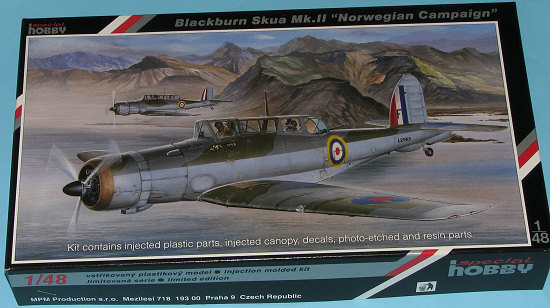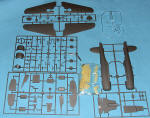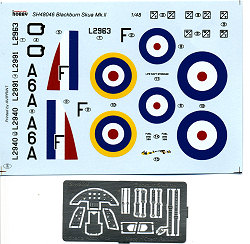
| KIT: | Special Hobby 1/48 Blackburn Skua II "Norwegian Campaign" |
| KIT #: | 48046 |
| PRICE: | $38.20 at GreatModels |
| DECALS: | Three options |
| REVIEWER: | Scott Van Aken |
| NOTES: | Multimedia kit with resin parts |

| HISTORY |
Built to Air Ministry specification O 27/34, it was a radical development for the Fleet Air Arm, being of all-metal construction and their first service monoplane. Its retractable undercarriage and enclosed cockpit were also new to a service that was primarily equipped still with open cockpit biplanes such as the Fairey Swordfish. Performance for the fighter role was compromised by the aircraft's low speed and relative lack of power. But the aircraft's armament of four fixed wing machine-guns and a single rearward-firing weapon were certainly effective in situations where crews were able to close with the enemy. For the dive-bombing role, a single 250 or 500-lb bomb was carried on a special swinging crutch under the fuselage which enabled the bomb to clear the propeller arc on release. Four 40-lb bombs or eight 20-lb 'Cooper' bombs could also be carried in racks under each wing. It had large 'Zap' type airbrakes/flaps which helped both in dive bombing and landing on aircraft carriers at sea.
Skuas are credited as the first British aircraft to shoot down an enemy aircraft in the Second World War: a Dornier Do 18 flying boat was downed over the North Sea on September 26, 1939 by three Skuas flying from the aircraft carrier HMS Ark Royal. On April 10, 1940 16 Skuas, led by LCDR William Lucy, flying from the Orkney Islands sank the German cruiser Königsberg in Bergen harbour during the German invasion of Norway. This was the first major warship ever to be sunk by dive bombing, indeed the first major warship ever sunk in war by air attack. Lucy later also became a fighter ace flying Skua. However, the two most experienced Skua squadrons, 800 NAS and 803 NAS were decimated during an attempt to bomb the battlecruiser Scharnhorst at Trondheim on June 13, 1940. Of fifteen aircraft on the raid, eight were shot down and the crews killed or taken prisoner. Among the latter were both squadron commanders, Captain R.T. Partridge (Royal Marines) and Lieutenant-Commander John Casson (Royal Navy).
Though it fared reasonably well against Axis bombers over Norway and in the Mediterranean, the Skua suffered heavy losses when confronted with modern fighters, particularly the Messerschmitt Bf 109, and they were withdrawn from front-line service in 1941. The aircraft was largely replaced by another two-seater, the Fairey Fulmar which doubled the Skua's forward armament and also boasted a speed advantage. A number of aircraft were converted to target tugs following withdrawal from frontline service. Others were in fact completed as target tugs from the factory and used by the RAF and Fleet Air Arm in this role ('Fleet Requirements'). They were also used as advanced trainers for the Fleet Air Arm. The last Skua in service was struck off charge in March 1945.
| THE KIT |
 This
is a kit that is quite typical of what MPM is currently producing. Most of the
kit is injected plastic, and that includes the four piece greenhouse canopy
assembly. Unfortunately, it appears that only the rear gunner's section can be
positioned open. Resin is used for the wheel wells and for the engine. The
engine is quite complex and includes separate cylinders and a myriad of small
exhaust stubs that feed into the collector that also is the forward part of the
cowling.
This
is a kit that is quite typical of what MPM is currently producing. Most of the
kit is injected plastic, and that includes the four piece greenhouse canopy
assembly. Unfortunately, it appears that only the rear gunner's section can be
positioned open. Resin is used for the wheel wells and for the engine. The
engine is quite complex and includes separate cylinders and a myriad of small
exhaust stubs that feed into the collector that also is the forward part of the
cowling.
A photo etch fret is used for instrument panels, belts
and harness as well as a black box or two and rudder pedals. An acetate sheet is
provided for instruments. The rest of the kit is very nicely detailed with
engraved panel lines and a fabric detailing that is not very pronounced. The
wings are two upper and lower halves with a separate center section that gets
glued to the fuselage prior to wing assembly. A separate lower rear fuselage
section holds the tail hook well. Interior detailing is quite extensive with two
large fuselage fuel tanks as were carried for the rather long range mis sions
to Norway from Northern Scotland. I was delighted that the prop is all one piece
but unfortunately, mine is missing a blade and it wasn't in the resealable bag
so had to have been packaged like that. Most of the clear bits had also broken
free from the sprue. Probably due to all the sprues rubbing against each other
and rattling around in a box that is a bit too large. This is a contestant
problem with kits from outside the US and I'm not sure what the answer is aside
from adding some sort of tissue or other packing to keep things tight in the
box.
sions
to Norway from Northern Scotland. I was delighted that the prop is all one piece
but unfortunately, mine is missing a blade and it wasn't in the resealable bag
so had to have been packaged like that. Most of the clear bits had also broken
free from the sprue. Probably due to all the sprues rubbing against each other
and rattling around in a box that is a bit too large. This is a contestant
problem with kits from outside the US and I'm not sure what the answer is aside
from adding some sort of tissue or other packing to keep things tight in the
box.
Instructions are well done with Humbrol and or Gunze paints given as a reference. All markings options are Dark Slate Grey/Sea Grey with Sky lower fuselage and right lower wing in black with the left lower wing in white. The 803 Sq Skua is lettered F in the fin flash and has a yellow surround to the fuselage insignia, while the 800 Sq plane has no fin flash and A6A tail codes and the other 803 Sq aircraft is also 'flashless' with the letter Q on the fin, the least colorful of the three. I'm sure the first option will be the one most build. Decals are superbly printed and should give excellent service.
| CONCLUSIONS |
This appears to be a fine kit and should supplant the Warrior resin kit in terms of ease of construction if not in terms of detail. There is already a Roc out and I'll have a look at that one when it arrives.
| REFERENCES |
http://en.wikipedia.org
August 2007
You can find this and many other fine kits and accessories at
www.greatmodels.com. Thank you for your
support. If you would like your product reviewed fairly and quickly by a
site that has nearly 400,000 visitors a month, please
contact
me or see other details in the
Note to
Contributors.